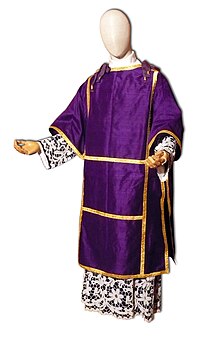Tunicella

The tunicella ( diminutive from the Latin tunica “small tunica”; also tunica stricta , dalmatica subdiaconalis , subucula , subtle or subdiaconale ) is the liturgical official garb of the subdeacon during holy masses , processions and blessings in the Catholic Church . The bishop also wore them under the dalmatic and the chasuble during the solemn pontifical office .
According to the first Roman Ordo , the tunicella was still a papal garment. From the 9th century onwards, it replaced the chasuble used by the subdeacons as a liturgical upper garment. At the end of the 12th century it was also widely used by bishops . The presentation of the tunicella to the sub-deacons at their ordination can be proven from the 12th century.
The tunicella is derived from the tunic used in antiquity and the Middle Ages as a lower and upper garment, the sides and sleeves of which could later be slit, from which the sleeve flaps were made. Tunicella and Dalmatik were characterized by horizontal stripes on the front and back from early on. In the early days, the subdeacon's tunicella differed from the deacon's dalmatic because of its narrower sleeves . Later it was adapted to this in color, cut and decoration, so that no real difference could be seen between the two garments. Occasionally the difference between the two garments can be recognized by the fact that the dalmatic has two horizontal stripes, while the tunicella has only one horizontal stripe between the two embroidered longitudinal stripes.
The bishop's tunicella, on the other hand, retained its peculiarities, and the bishop's tunicella ( dalmatica minor ) and dalmatic ( dalmatica maior ) were mostly made of thinner material, since they only functioned as an undergarment under the chasuble . The fullness of the sacrament of Holy Orders in the episcopate was to be symbolized by wearing all three pieces of clothing .
The tunicella was originally white, adapted to the liturgical color canon in the late Middle Ages and was always based on the color of the chasuble of the celebrating priest . The white vestments were considered celebration robes, so that subdeacons and deacons on penitential days, in Advent and Lent contributed not tunicle and dalmatic, but a dark-colored chasuble or alb without robe. It became a custom for them to wear the chasuble as a planeta plicata , rolled up or tied up in front.
With the suspension of the dispensation of minor orders (and thus also the quasi-abolition of the subdiaconate in the ordinary form of the Roman rite ) by the Motu Proprio Ministeria quaedam of Paul VI. the tunicella came largely out of use as an episcopal undergarment. It is only used in the extraordinary form of the Roman rite .
literature
- Theodor Bogler , Art. Tunicella , in: Lexikon für Theologie und Kirche , Vol. 10, Herder, Freiburg (Breisgau) 2nd, completely revised edition 1965, Col. 404.
- Walter von Arx, Art. Dalmatik u. Tunicella , in: Lexicon for Theology and Church , Vol. 2, Herder, Freiburg (Breisgau) 3rd edition 1994, Sp. 1380f.
- Joseph Braun : The Liturgical Paraments in the Present and Past. Reprographical reprint of the second, improved edition, Verlag nova & vetera, Bonn 2005, ISBN 3-936741-07-7 , pp. 89-100 (1st edition: 1911, 2nd edition: 1924).